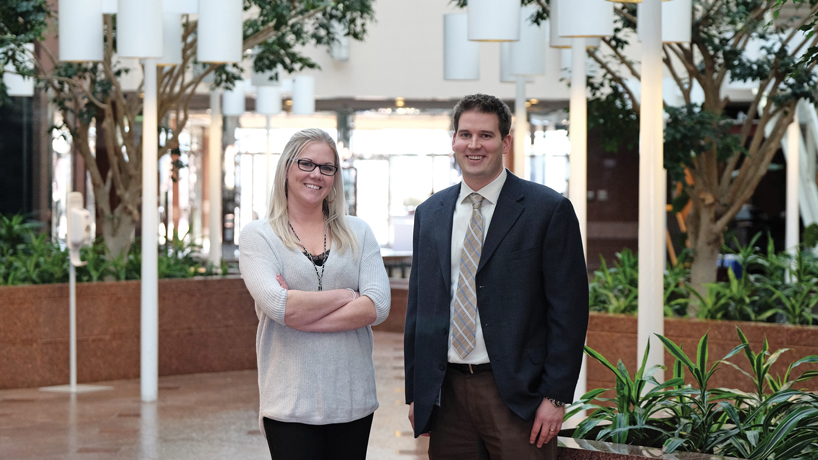
Kasey Woods and John Waterhouse, alumni of the UMSL/Washington University in St. Louis Joint Undergraduate Engineering Program, put their electrical engineering know-how to great use. (Photo by August Jennewein)
As Ameren Corporation constructs the Illinois Rivers Transmission Line to address regional reliability needs and provide Missouri and Illinois with greater access to renewable energy resources, a pair of University of Missouri–St. Louis alumni will help guide the project to completion.
John Waterhouse and Kasey Woods are two of the three project managers overseeing the construction of the 385-mile, high-voltage power line approved by the Midcontinent Independent System Operator. The 345-kilovolt power line will travel from eastern Missouri across the state of Illinois and will consist of nine line segments with three major river crossings and 10 substations.
It’s what Waterhouse calls an “energy highway.”
“A new transmission line project is usually much shorter – maybe 20 to 30 miles at the most,” Waterhouse says. “When we work on those, we are trying to improve reliability or congestion issues in that immediate area. This is much bigger. More than providing benefits to Ameren customers, it will carve out a path for renewable energy for the region.”
“It’s the largest transmission investment Ameren has ever made,” Woods says. “And it’s the second largest project Ameren has ever invested in – second only to Callaway Nuclear Generating Station [near Fulton, Mo.].”
It’s not the first time Waterhouse and Woods have worked together either. They met in the UMSL/Washington University in St. Louis Joint Undergraduate Engineering Program, where they had classes together and took advantage of the exact same co-op position arranged through the program’s partnership with Ameren. Each graduated in 2006 with a bachelor’s degree in electrical engineering.
Their co-ops turned into full-time jobs at Ameren, where they worked their way up to project management roles. Now they’re in charge of the second largest project ever for the corporation.
Waterhouse is responsible for the 10 substations, which serve as integration points into the existing electrical grid.
“Lines can split off, redirect and extend into different areas,” he says. “The substations also transform the 345 kV down to 138 kV for more manageable use.”
Woods oversees all three river crossings, which have transmission towers that dwarf typical transmission steel pole structures, usually 160 feet tall.
“The shortest structures for these river crossings are 190 feet tall, and the tallest will be about 490 feet when we’re done,” she says.
The nine line segments are overseen by their fellow project manager, and in all, the entire Illinois Transmission River Project is slated for completion in 2018.
“Currently two substations are completed with the remaining eight under construction,” Waterhouse says.
For Woods, the Mississippi River crossing is in the final phase. It has six tower structures, the most at any one river crossing for the project, but not the tallest. The other two crossings, still underway, have four taller towers each.
When Waterhouse and Woods aren’t teaming up to help bring renewable energy to Midwest households, they team up for other important activities – like volleyball.
“Volleyball is serious,” Waterhouse teases as they both look ahead to the game later. “We’re on the same team,” Woods explains. UMSL classmates. Co-op students. Ameren project managers. And now volleyball?
It seems they’ve always been a team, and a good one at that.
This story was originally published in the spring 2016 issue of UMSL Magazine.















